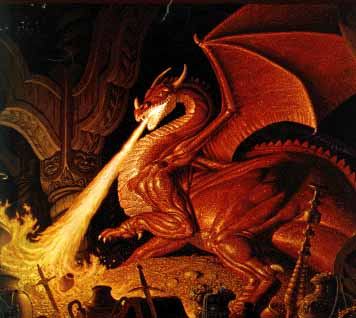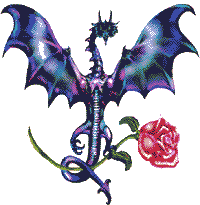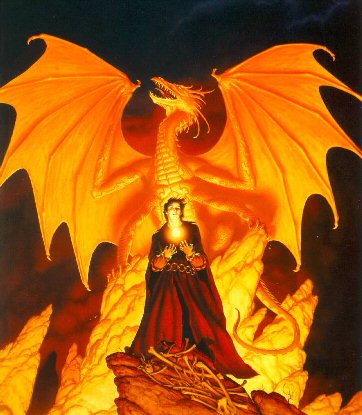|
Dragons and Winged Serpents  Dragons, Snakes, and Pearls are symbols for human DNA,
Fire representing soul sparks of light emanating from the flame of creation. Dragons are winged beings portrayed in the ancient mythologies of most cultures. They link with winged gods from the heavens who came to Earth to create the human race and are very important symbology in the creational blueprint of our reality. Much of dragon lore tells us that dragons were loathsome beasts and evil enemies to humankind. But dragons were born of a time other than men; a time of chaos; a time of creation out of destruction. The dragon is a fabulous and universal symbolic figure found in most cultures thought the world. 
Some examples of the symbology of the dragon are: - Gnostics: "The way through all things." - Alchemy: "A winged dragon - the volatile elements; without wings - the fixed elements." - Chinese: "The spirit of the way"' bringing eternal change. - Guardian of the 'Flaming Pearl" symbol of spiritual perfection and powerful amulet of luck. The early Chinese believed in four magical, spiritual and benevolent animals; the Dragon, the Phoenix, the Tortoise and the Unicorn. The Dragon was the most revered of all. In it's claws it holds an enormous magical pearl, which has the power to multiply whatever it touches. The ancients believed the "pearl" symbolized the most precious treasure; Wisdom. 
Many legends say they were fabulous animals usually represented as a monstrous winged and scaly serpent or saurian with a crested head and enormous claws. - also - a monster, represented usually as a gigantic reptile breathing fire and having a lion's claws, the tail of a serpent, wings and scaly skin. The various figures now called dragons most likely have no single origin, but spontaneously came to be in several different cultures around the world, based loosely on the appearance of a snake and possibly fossilized dinosaur remains. Mythology about dragons appear in the traditions of virtually all peoples back to the beginning of time - though dragons appeared in various forms. Among their earliest forms, dragons were associated with the Great Mother, the water god and the warrior sun god. In these capacities they had the power to be both beneficent and destructive and were all-powerful creatures in the universe. Because of these qualities, dragons assumed the roles taken by Osiris and Set in Egyptian mythology. By the time of the early Egyptian period a considerable dragon- and serpent-worshipping cult had developed. This cult gradually spread to Babylon, India, the Orient, the Pacific Islands, and finally the North American continent, as more and more cultures began to recognize and appreciate the special powers and intelligence of dragons. The cult reached its peak during the days of the Roman Empire and disappeared with the advent of Christianity. The dragon's form arose from his particular power of control over the waters of the earth and gave rise to many of the attributes singled out by different peoples as the whole myth developed. They were believed to live at the bottom of the sea, where they guarded vast treasure hoards, very frequently of pearls. Rain clouds and thunder and lightning were believed to be the dragon's breath, hence the fire-breathing monster. The significance of the dragon was its control over the destiny of mankind. 
As the myth developed in the western world, dragons came to represent the chaos of original matter with the result that with man's awakening conscience a struggle arose, and the created order constantly challenged the dragon's power. This type of dragon was considered by many to be the intermediate stage between a demon and the Devil and as such came into Christian belief. However, in the Eastern world the dragon adopted a rather different significance. He was essentially benevolent, son of heaven, and controlled the watery elements of the universe. Dragons have been an integral part of the culture of the Chinese, Koreans and Japanese peoples since the beginning of recorded history. In China they are used to mark the stairways over which only the Emperor could be carried. In Japan they are used in Buddhist temples both as decoration and as fountain heads for purification before worship. In many cases the dragon is combined with the phoenix to symbolize long life and prosperity. It is also combined with the tiger to represent heaven and earth or inyo (Yin and Yang). The male dragon holds a war club in its tail while the female dragon holds a sensu or fan in its tail. One of the problems lies in that you cannot always see the tail or tell the difference between the fan or the war club. The Chinese dragon is a central figure of both good and evil in their fables and legends. According to the Chinese the dragon originated in their middle kingdom and has always had five toes. The dragon by nature is a gregarious creature who wanders the earth. However, the farther it goes from China, the more toes it loses. Hence, when it reached Korea it only had four toes and by the time it got to Japan it only had three. This also explains why it never made it to Europe or the Americas in that by the time it got that far it had lost all of its toes and could not walk.  Information found on Crystalinks Information found on Crystalinks |  Free Forum Hosting
Free Forum Hosting